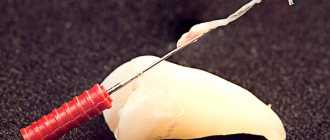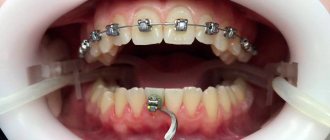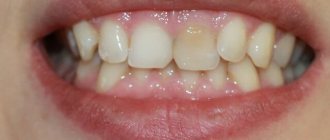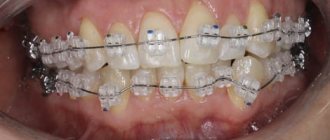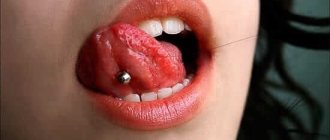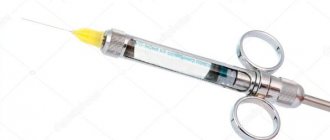What is local anesthesia
The main distinguishing feature of local anesthesia is that the person remains conscious during its effect. This type of anesthesia acts on receptors that are located below chest level. In addition to complete anesthesia, local anesthesia eliminates other tactile sensations, including temperature, pressure on tissue, or stretching.
Local anesthesia is possible in the following areas:
- on the surface of the mucous membranes of various organs - trachea, larynx, bladder, bronchi, and so on;
- in the thickness of tissue - bone, muscle or soft;
- in the direction of the nerve root extending beyond the boundaries of the spinal cord membrane.
- in impulse-conducting nerve cells of the spinal cord.
The main goal of local anesthesia is to block the occurrence of impulses and their transmission while maintaining consciousness.
Injection anesthesia in dentistry
Dental treatment
without pain relief, the process is so unpleasant that many can imagine it as their personal nightmare. However, now this is no longer the case: modern dentistry offers a wide selection of painkillers and anesthetic drugs, which allow you to feel nothing at all during the treatment and extraction of teeth, and to carry out the most complex dental operations, including dental implantation, without any discomfort for the patient. The power of modern drugs is 5-6 times higher, and the harm to health is many times lower, compared to those drugs that were used 15-20 years ago.
Nowadays, anesthesia is carried out for almost any type of dental treatment, with the exception of professional teeth cleaning.
(air flow, ultrasonic cleaning, enamel polishing). Due to the large number of nerve endings in the oral cavity, anesthesia is used during treatment, during tooth extraction, and during prosthetics/implantation and other complex manipulations.
The dentist chooses the drug, its dosage and type of anesthesia individually, depending on the patient’s age, characteristics of his body, allergic reactions, etc.
The most popular and effective type of pain relief is local anesthesia
– allows you to anesthetize a specific area of the oral cavity without plunging the patient into an unconscious state and without in any way affecting his perception of what is happening. The patient remains conscious, responds to the doctor’s comments and requests, and can control the process of his treatment.
Injection anesthesia
- This is an injection that blocks the nerve and the area of soft tissue around it. Complete numbness occurs, which lasts about one and a half to two hours - time that is just enough for most dental procedures. After the anesthesia wears off, there are no side effects or unpleasant consequences, and this is one of the main advantages of using local anesthesia. At As-Stom dental clinics, local dental anesthesia is actively used.
One of the most effective injectable drugs is Ultracaine - this drug can be used for asthma, allergic reactions and even endocrine diseases.
Contraindications to injection anesthesia:
- Reduced blood clotting, use of certain medications (anticoagulants) that impede blood clotting, as well as antidepressants and adrenergic blockers;
- Diseases of the endocrine system, diabetes mellitus;
- Cardiovascular diseases, pathologies (tachycardia, etc.);
- Liver and kidney failure.
In addition, it is not recommended to administer anesthesia on an empty stomach. It is best to eat 1.5-2 hours before visiting the dentist.
To eliminate the fear of an injection, anesthesia using the application method
.
To do this, soak a cotton swab with an anesthetic solution and place it on the part of the gum that needs to be “frozen.” This anesthesia does not last long, about 25-30 minutes, but this is enough to administer an anesthetic injection without fear and pain. Most often, this method is used in pediatric dentistry
so that the child is not afraid of the injection and does not feel anything.
Types of local anesthesia
In medicine, there are the following types of anesthesia, differing in some characteristics and scope of application:
- terminal;
- infiltration;
- regional;
- intravascular.
Each type has a list of indications and contraindications that must be taken into account when conducting them.
Terminal anesthesia
This type is also known as topical or surface anesthesia. The main areas of application are dentistry, gastroenterology and proctology. Terminal local anesthesia (anesthesia) differs from other types in the method of administration: anesthetics in the form of a spray, gel or ointment are applied to the surface of the skin or mucous membranes.
In proctology, local anesthetic gels and sprays (Katetdzhel, Lidochlor, Lidocaine, etc.) are used during proctological examinations and diagnostic procedures: rectal examination, anoscopy, sigmoidoscopy. The examination becomes virtually painless. Also, local anesthesia in proctologists is used during certain medical procedures: latex ligation of hemorrhoids, sclerotherapy of hemorrhoids, infrared coagulation of internal hemorrhoids, as well as biopsy from the rectum.
Infiltration anesthesia
It is used in dentistry and surgery, and involves the introduction of special solutions into soft tissues. The result of the procedure, in addition to a pronounced anesthetic effect, is an increase in pressure in the tissues, and, as a result, a narrowing of the blood vessels in them.
Regional anesthesia
This type involves the introduction of an anesthetic near large nerve fibers and their plexuses, resulting in pain relief in localized areas. It is divided into the following types of local anesthesia:
- conduction, with the introduction of drugs near the trunk of a peripheral nerve or nerve plexus;
- spinal, with the introduction of drugs into the space between the membranes of the spinal cord and “turns off” pain receptors over a large area of the body;
- epidural anesthesia, with the introduction of drugs into the space between the spinal cord and the walls of the spinal canal through a special catheter.
Intravascular anesthesia
It is used mainly for surgical interventions on the extremities. Administration of drugs is possible only with the application of a hemostatic tourniquet. The anesthetic is injected into a blood vessel located near the nerve responsible for the sensitivity of the limb in the area below the injection site.
In recent years, due to the emergence of more effective local anesthetics, the number of proctological operations performed using local anesthetics has increased significantly. In addition, our specialists have developed a method of combined anesthesia - a combination of local anesthesia and intravenous anesthesia. This significantly reduces the toxicity of general anesthesia and reduces the severity of pain in the postoperative period, which allows the patient to recover faster after surgery.
Most often, when performing proctological operations (hemorrhoidectomy, excision of anal fissures, small pararectal fistulas, rectal polyps), pararectal blockade, as well as spinal anesthesia, are used.
When is it reasonable to treat teeth under anesthesia?
In modern dentistry, anesthesia is often used not only for complex and lengthy operations, but also for routine dental treatment, grinding for dentures, tooth extraction, and in pediatric dentistry. However, it makes sense to use both general anesthesia and sedation in certain cases and for certain patient conditions:
- If long-term and complex treatment is planned (removal of several teeth at a time, bone grafting operations);
- If the patient suffers from a serious form of dental phobia or dentophobia (fear of the dentist and dental instruments);
- If the patient has diseases associated with an irresistible gag reflex, involuntary nervous convulsions;
- If the patient is allergic to local anesthetic drugs.
In dentistry, patients do not remain in the hospital after general anesthesia, but may well go home after
Preparations for local anesthesia
The following drugs are used to provide local anesthesia:
- Novocaine;
- Dicaine;
- Lidocaine;
- Trimecaine;
- Bupivacaine;
- Naropin;
- Ultracaine.
Each of them is effective when carrying out a certain type of anesthesia. Thus, Novocaine Dicaine and Lidocaine are more often used when it is necessary to anesthetize the skin and mucous membranes, while more powerful drugs, such as Naropin and Bupivacaine, are used for spinal and epidural anesthesia.
Indications for local anesthesia
All methods of local anesthesia have the same list of indications, and are used if necessary to numb a specific area for a short time (up to an hour and a half). It is recommended to use them:
- for performing surgical non-abdominal interventions or small abdominal operations, the duration of which does not exceed 60-90 minutes;
- with intolerance to general anesthesia;
- if the patient is in a weakened state;
- if it is necessary to carry out diagnostic procedures against the background of severe pain;
- if the patient refuses general anesthesia;
- in elderly patients;
- when general anesthesia cannot be used.
Anesthesia for pregnant women during dental treatment
During pregnancy and breastfeeding, the patient needs to select an anesthetic drug especially carefully. Many drugs can harm the unborn child, so in the early stages (the first two months), when the fetus is forming, it is better to refrain from visiting the dentist if an operation with anesthesia is to be performed. Also, dental operations are not performed in the last two months of pregnancy.
The optimal time for dental treatment with anesthesia is the second trimester of pregnancy. For treatment, injection anesthesia is chosen, and the injection is given very precisely, with a small amount of the drug.
During lactation, if the mother has to undergo dental treatment with anesthesia, it is recommended to temporarily transfer the child to artificial nutrition until the drug is completely eliminated from the body.
Not available for pregnant women:
- General anesthesia.
Possible complications when using local anesthesia
The use of local anesthetics carries certain risks, which include several types of complications:
- damage to the central nervous system and conduction system of the heart;
- damage to spinal tissue, nerve roots and spinal cord membranes;
- suppuration at the site of anesthetic injection;
- allergic reactions.
In most cases, the listed problems arise when the anesthesia technique is violated, or when the anamnesis is not collected completely.
Is anesthesia harmful in dentistry?
Properly administered anesthesia, in which the immersion in and out of sleep is carried out by an experienced anesthesiologist, does not have any further harmful effects on the body. Contrary to terrible rumors, it does not take away 5 years of life, does not affect potency, is not addictive, and in general, modern drugs allow you to perform an operation under anesthesia with a minimum of side effects. Yes, the load on the body during general anesthesia is quite high, but in cases where anesthesia really needs to be used, it is justified.
However, discomfort after anesthesia, unfortunately, is inevitable and continues for 12-24 hours after surgery. These include:
- Nausea and vomiting. The most common effect, which is most clearly manifested in women, young people under 30 years of age, as well as non-smokers and those suffering from seasickness;
- Chills - manifested due to anesthesia, which suppresses the body’s thermoregulation and slows down metabolic processes, due to vasodilation and a decrease in pressure;
- Headache, dizziness and drowsiness, clouded consciousness and difficulty thinking - arise due to the effect on human consciousness. This is a normal reaction of the body, more pronounced in older people.
Only an anesthesiologist can tell you the exact time when the side effects of anesthesia will go away. This depends on many factors: the gender and age of the patient, the condition of his body, his height and weight, etc.
